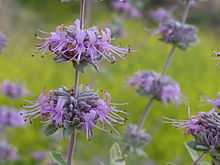Salvia leucophylla
| Salvia leucophylla | |
|---|---|
 | |
| Scientific classification | |
| Kingdom: | Plantae |
| (unranked): | Angiosperms |
| (unranked): | Eudicots |
| (unranked): | Asterids |
| Order: | Lamiales |
| Family: | Lamiaceae |
| Genus: | Salvia |
| Species: | S. leucophylla |
| Binomial name | |
| Salvia leucophylla Greene | |
Salvia leucophylla (Purple sage, Gray sage) is an aromatic sage native to the southern coastal mountain ranges of California and Baja California.[1]
Taxonomy
The plant's specific epithet, leucophylla, describes the light grayish leaves. The type specimen was collected near Santa Barbara, California by Scottish botanist David Douglas and named by Edward Lee Greene in 1892. The common names refer to the pale purple flowers (Purple sage) or to the grayish leaves (Gray sage).[1]
Description
S. leucophylla is an evergreen shrub that grows up to 1 to 1.5 m (3.3 to 4.9 ft) tall and wide. Leaves are a light green in the spring, turning grayish-white as they mature, with graceful branches that arch to the ground, sometimes rooting when they touch the ground. Flowers grow in tight whorls on 15 to 20 cm (5.9 to 7.9 in) long inflorescences, with a pinkish-purple flowering stem. The 2.5 cm (0.98 in) flowers are pinkish-purple, held in a purple-tinged gray calyx.[1]
Habitat
The plant is typically found on dry hillsides and in gravelly soils.[1]
Cultivation
S. leucophylla is widely used in California and xeriscape gardening, preferring full sun and good drainage. There are many cultivars, natural hybrids, and wild hybrids with other Salvia species, making clear naming very confusing.
Some cultivars include:
- Salvia leucophylla 'Pt. Sal'
- Salvia leucophylla 'Figueroa'
- Salvia leucophylla 'Bee's Bliss'[1]
S. leucophylla is known to have allelopathic qualities. It releases a compound in the air that can drift to nearby earth and interfere with seedling growth for many species of plants. [2]
See also
- California native plants
- California chaparral and woodlands
References
External links
| Wikimedia Commons has media related to Salvia leucophylla. |